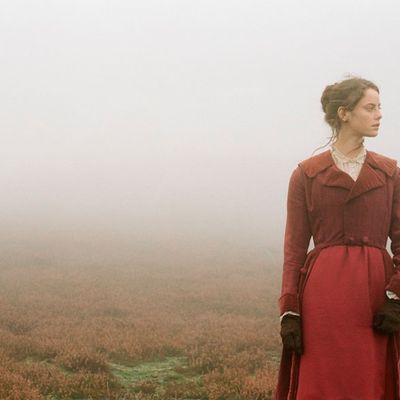
Having tremendous respect for writer-director Andrea ArnoldÔÇÖs Red Road and Fish Tank, I writhed in discomfort through most of Wuthering Heights┬áÔÇö specifically, through any shot with people as opposed to wind, rain, or wind and rain together, or various parts of the unruly Yorkshire landscape. Arnold, you see, has chosen to counter the stuffiness of old-fashioned Great Literature adaptations by making the style of the film an objective correlative for the loversÔÇÖ uncontrollable passion, which means a camera that sways and swerves and sometimes fairly trembles with longing. The theory works. The movie doesnÔÇÖt.
ArnoldÔÇÖs Heathcliff (Solomon Glave when young; James Howson when he trudges back to Wuthering Heights after a long absence) is black, a bold choice that works ÔÇö especially given that previous Heathcliffs (from Laurence Olivier to Timothy Dalton) would have looked quite at home in Yorkshire with slightly better grooming. This one can never entirely fit in. And when heÔÇÖs ordered around, beaten up, and called the N-word by Hindley Earnshaw (Lee Shaw ÔÇö whose name, oddly enough, takes the last syllables from his characterÔÇÖs), the movie has a social sting that isnÔÇÖt out of place.
Glave and Howson come together in your mind, one growing out of the other, whereas the two Cathys, Shannon Beer and Kaya Scodelario, are a study in discontinuity. Beer is cute, expressive, a bit of a pudge. Scodelario, best known for the notorious U.K. series Skins, has a drawn, model-chiseled face and blue peepers that take up half her face. Worse, HeathcliffÔÇÖs flight from Wuthering Heights has taken all the fight out of her. SheÔÇÖs a simp.
I shouldnÔÇÖt blame the actress when itÔÇÖs hard even to focus on her. Emily Bront├½ÔÇÖs prose is more rough-hewn than her sisterÔÇÖs, but ArnoldÔÇÖs attempt at a similar sort of emotional rawness ends up, ironically, distancing the audience. The cameraman is so into their scenes ÔÇö he must have taken Method acting classes ÔÇö that itÔÇÖs as if Heathcliff and Cathy only see each other in motion. Claire Denis can bring off this sort of expressionist style, and Paul Thomas Anderson gets it more than halfway in The Master. But ArnoldÔÇÖs other films were essentially realistic, nudged into a subtle expressionism by her female protagonistsÔÇÖ gradual loss of self-control. Here, she comes off as a flounderer. The random physical detail ÔÇö a shot of a moth or the back of CathyÔÇÖs puffy dress as Heathcliff rides behind her on horseback ÔÇö just looks odd. Thinking back a week after seeing Wuthering Heights, I remember the moth and those windy moors and CathyÔÇÖs brother hurling the N-word. I remember a branch tapping on the window (CathyÔÇÖs ghost?) and the agony of the loversÔÇÖ separation ÔÇö their writhing and head-banging. I just never got the part where they fell in love.


